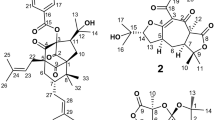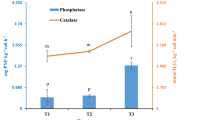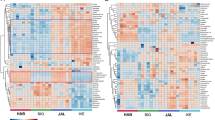Abstract
THE ripened seed capsules of tutsan (Hypericum androsemium) were dried, ground and extracted with petroleum ether (60°–80° C) followed by further extraction with acetone. The residue from the evaporated acetone extract, on vacuum sublimation, yielded a colourless solid, which crystallized from acetone–petrol in colourless plates m.p. 184°, with analysis C, 48.1; H, 5.8 per cent. C7H10O5 requires C, 48.2; H, 5.8 per cent. Preliminary tests showed unsaturated and acidic properties. The infra-red spectrum proved to be identical with that of shikimic acid1 (cyclohex-1-ene-3 : 4 : 5-triol-1-carboxylic acid) which is recorded in D.M.S. spectrum 2635.
This is a preview of subscription content, access via your institution
Access options
Subscribe to this journal
Receive 51 print issues and online access
$199.00 per year
only $3.90 per issue
Buy this article
- Purchase on SpringerLink
- Instant access to full article PDF
Prices may be subject to local taxes which are calculated during checkout
Similar content being viewed by others
References
Fischer, H. O. L., and Dangschat, J., Helv., 20, 705 (1937).
Author information
Authors and Affiliations
Rights and permissions
About this article
Cite this article
HARGREAVES, K. Shikimic Acid, a Constituent of Tutsan Berries. Nature 206, 830 (1965). https://doi.org/10.1038/206830a0
Issue date:
DOI: https://doi.org/10.1038/206830a0
This article is cited by
-
Modern state of the chemical study of species of the genusHypericum
Chemistry of Natural Compounds (1987)
-
Hyperin and Nonacosane Constituents of Tutsan
Nature (1966)



